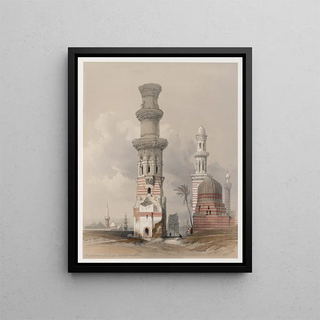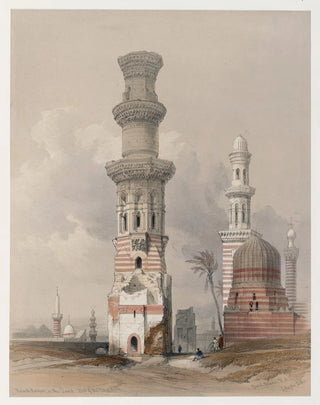Art print | Ruined mosques in the desert west of the citadel - David Roberts


View from behind

Frame (optional)
The canvas "Ruined mosques in the desert west of the Citadel," an iconic work by David Roberts, transports us to a world where the sublime and the desolate intersect. Through this depiction, the artist evokes the remnants of a bygone grandeur, bearing witness to an era when Islamic architecture shone brightly in desert regions. The composition, both majestic and melancholic, invites viewers to reflect on the passage of time and the fragility of civilizations. Contemplating this piece, one feels a deep connection to history, an immersion into a landscape filled with mystery and poetry.
Style and uniqueness of the work
David Roberts, master of romantic landscape painting, stands out for his ability to capture the light and atmosphere of the places he depicts. In "Ruined mosques in the desert west of the Citadel," he employs warm colors and subtle nuances to create an ambiance that is both serene and emotionally charged. The ruins of the mosques, though degraded, retain a striking beauty, testifying to the art and culture that marked their era. The finesse of details, from architectural ornaments to play of shadow and light, reveals a profound respect for cultural heritage. The work also distinguishes itself through its perspective, inviting the viewer to explore the desert landscape, both vast and intimate, where each element seems to tell a story.
The artist and his influence
David Roberts, born in Scotland in 1796, is renowned for his travels through Egypt, Syria, and Palestine, which profoundly influenced his art. As a pioneer of orientalism, he captured the essence of the landscapes and monuments he encountered, offering a unique vision of these regions to the European public of the 19th century. His works, including "Ruined mosques in the desert west of the Citadel," are not only testimonies of his explorations but also reflections on the encounter between the Orient and the West. Roberts has inspired many artists and continues to influence perceptions of orientalistic art.

Matte finish

View from behind

Frame (optional)
The canvas "Ruined mosques in the desert west of the Citadel," an iconic work by David Roberts, transports us to a world where the sublime and the desolate intersect. Through this depiction, the artist evokes the remnants of a bygone grandeur, bearing witness to an era when Islamic architecture shone brightly in desert regions. The composition, both majestic and melancholic, invites viewers to reflect on the passage of time and the fragility of civilizations. Contemplating this piece, one feels a deep connection to history, an immersion into a landscape filled with mystery and poetry.
Style and uniqueness of the work
David Roberts, master of romantic landscape painting, stands out for his ability to capture the light and atmosphere of the places he depicts. In "Ruined mosques in the desert west of the Citadel," he employs warm colors and subtle nuances to create an ambiance that is both serene and emotionally charged. The ruins of the mosques, though degraded, retain a striking beauty, testifying to the art and culture that marked their era. The finesse of details, from architectural ornaments to play of shadow and light, reveals a profound respect for cultural heritage. The work also distinguishes itself through its perspective, inviting the viewer to explore the desert landscape, both vast and intimate, where each element seems to tell a story.
The artist and his influence
David Roberts, born in Scotland in 1796, is renowned for his travels through Egypt, Syria, and Palestine, which profoundly influenced his art. As a pioneer of orientalism, he captured the essence of the landscapes and monuments he encountered, offering a unique vision of these regions to the European public of the 19th century. His works, including "Ruined mosques in the desert west of the Citadel," are not only testimonies of his explorations but also reflections on the encounter between the Orient and the West. Roberts has inspired many artists and continues to influence perceptions of orientalistic art.






